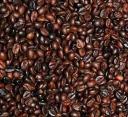 There is much to be said about the perfect cup of coffee, and yet so much is clouded by old wives’ tales and misinformation. What counts is simple math and physics, and as long as you understand the chemistry of coffee you can produce a perfect cup every time.
There is much to be said about the perfect cup of coffee, and yet so much is clouded by old wives’ tales and misinformation. What counts is simple math and physics, and as long as you understand the chemistry of coffee you can produce a perfect cup every time.
Grind
The finer you grind the coffee beans, the more character you will get from each bean. In other words, more flavor can be extracted from the same amount of beans if they are ground finer. But it’s the type of coffee making equipment you own that will determine what grind you can get away with.
 The reason is due to the flavor compounds present in a coffee bean. “Good” flavors are extracted early in the brewing process, while “bad” flavors come out later. Allowing the grounds to come in contact with too much water will lead to over-extraction and a nasty tasting brew. Your equipment will determine how much water comes into contact with your grounds and for how long.
The reason is due to the flavor compounds present in a coffee bean. “Good” flavors are extracted early in the brewing process, while “bad” flavors come out later. Allowing the grounds to come in contact with too much water will lead to over-extraction and a nasty tasting brew. Your equipment will determine how much water comes into contact with your grounds and for how long.
An espresso machine, on the fine end of the scale, is designed to force a small amount of water through very tightly packed and finely ground coffee. The idea is to get a concentrate of only the best tasting flavors. Therefore, it is critical to have an even grind.
Contaminants
Your cup of brew can have anything from chlorine, minerals, salts, heavy metals, and even traces of diesel in it. Ninety-nine percent of these are the fault of your water source.
Use a charcoal filter to clean the water you use to brew with. These come in models that attach to your faucet or can be installed over the intake valve of your coffee maker. Make sure you replace the filter according to the maker’s guidelines or when you can taste a drop in the quality of your water. It would help to purchase a small bottle of filtered water to use as your base of comparison.
If you use a drip coffee maker, use unbleached paper filters or permanent gold wire mesh filters. For the later, be sure to rinse them well in fresh water.
Quantities
One level tablespoon of coffee per cup is the standard and works well regardless of your coffee maker. We do not recommend making batches any larger than 10 cups at a time, since the higher volume of water will cause over-extraction.
Some drip coffee makers come with a dial on top of the unit that allows a portion of the hot water to go directly into the pot without passing through the grounds first. These dials allow less water to pass through the coffee, avoiding over-extraction and producing a stronger brew. It is diluted back to normal strength by the water that bypasses the coffee grounds.
Age
Coffee releases six times its volume in carbon dioxide within the first 48 hours of roasting.
Green coffee is almost impervious to aging and can be stored in your cellar for years. But once it’s roasted, the flavor degrades immediately and gets worse over time. If you really like the taste of coffee, know that it all comes from the skill of the roaster.
Keep a mill-type grinder next to your coffee machine and grind only enough coffee for the pot you’re about to make.
Never ever use the “community grinders” present in the coffee aisles of supermarkets. Who knows what has been put through them or when they were last cleaned.
Once the coffee is brewed, switch off the heating element and serve the beverage immediately. If you find that you are brewing more than you can drink at once, consider either making smaller batches or storing the remainder in a thermal flask. Do not microwave cold coffee and do not switch the heating element back on.
The perfect cup of coffee takes practice and knowledge. DRINK UP!
Making the coffee at Mugsy’s
You may order Mugsy’s coffee online at http://www.mugsyscoffeeco.com

